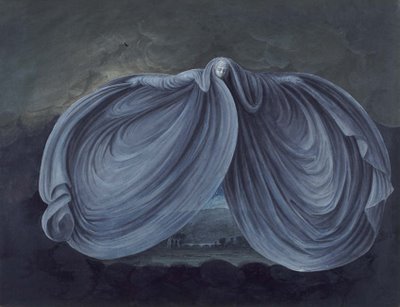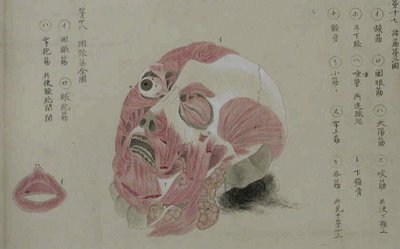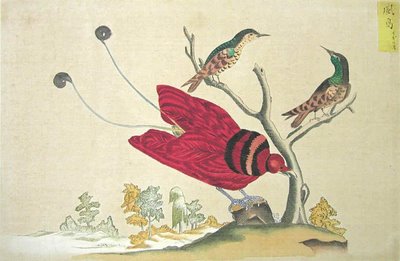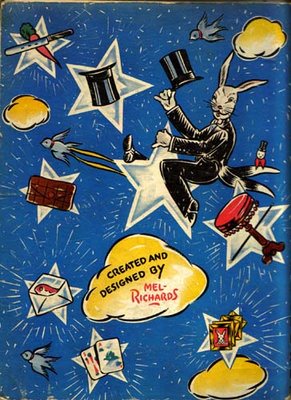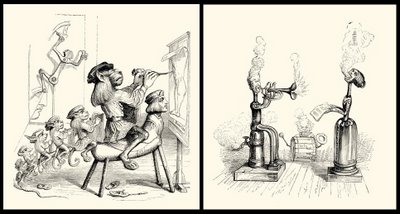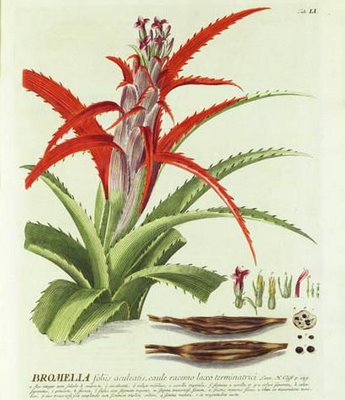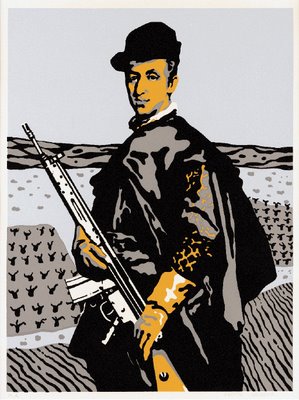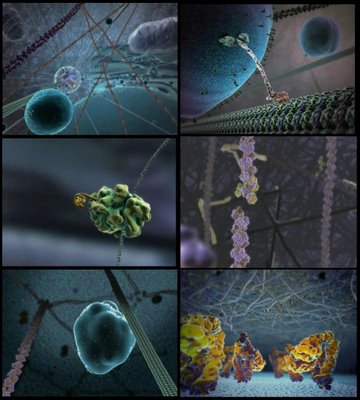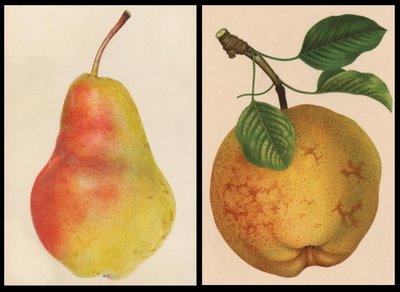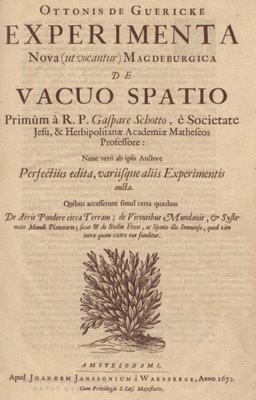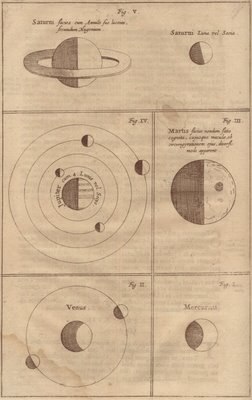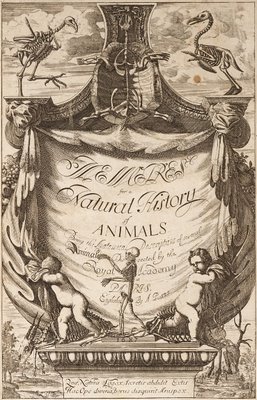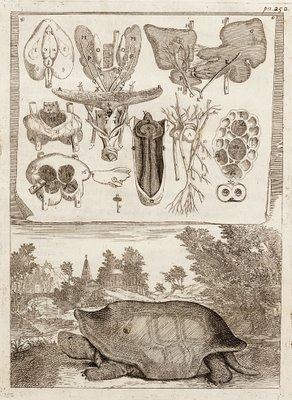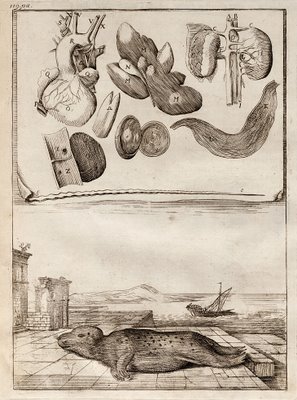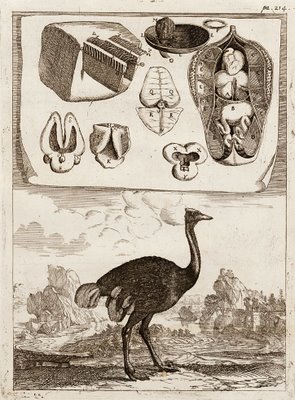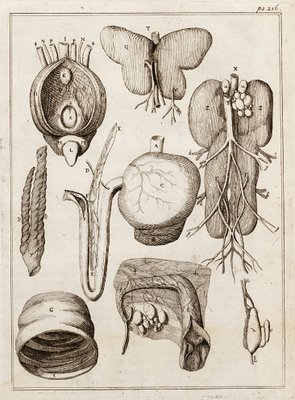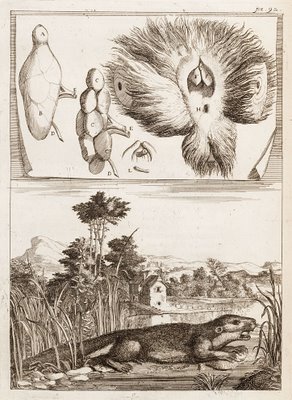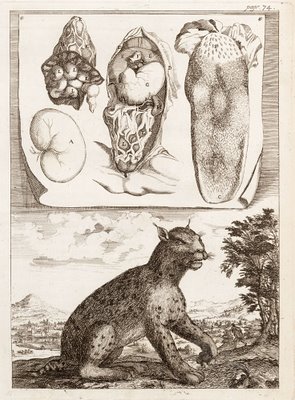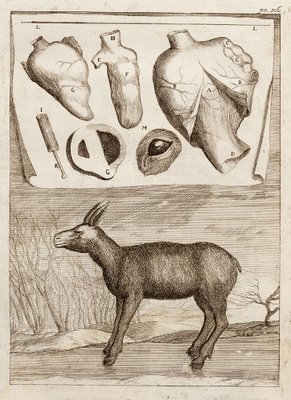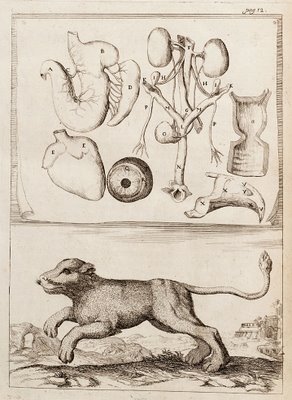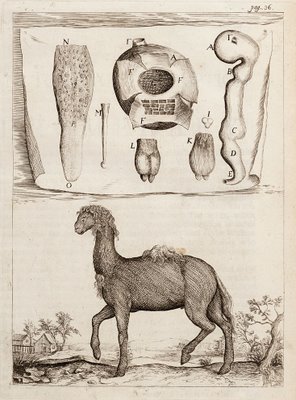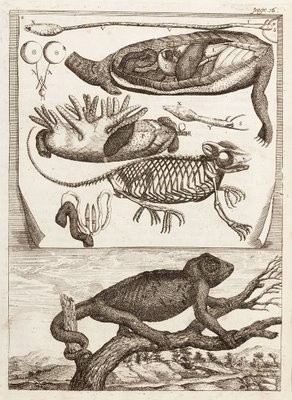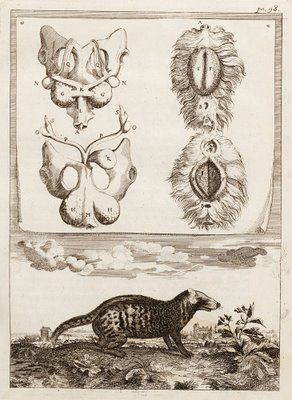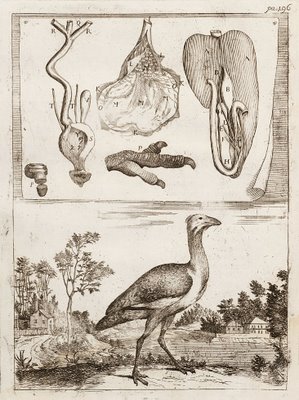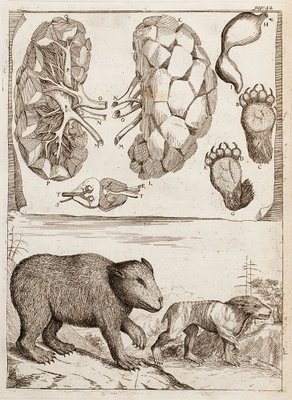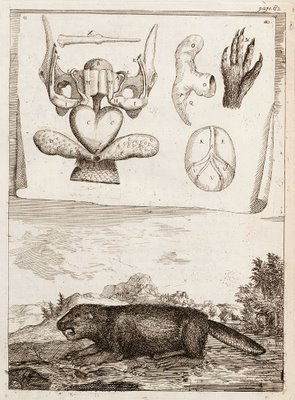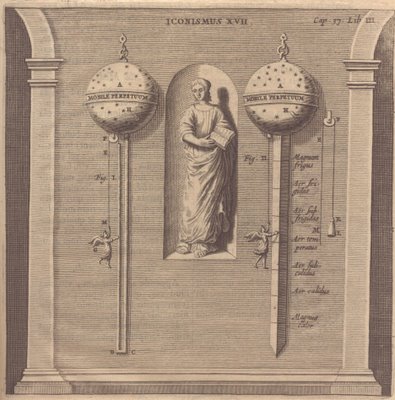
'Thermotrum novum Magdeburgicum dictum'
"This thermometer was over twenty feet in length and this plate shows how it would have been fixed to a wall of a house. The instrument on the left consists of a large copper sphere to which is attached one arm of a long U-tube containing alcohol. The other arm, on the right, is open to the air, and within it hangs a float counterbalanced by a figure of an angel which serves as an indicator on a scale of seven degrees, from 'great heat' to 'great cold'."
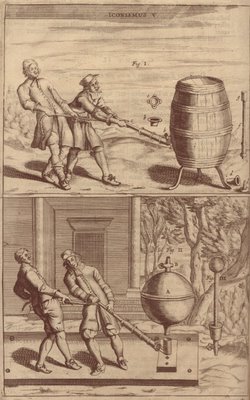
'Fig. I. - De primo experimento vacui, per extractionem aquae.
Fig. II. - De secundo experimento, per aeris extractionem comparandi vacuum.'
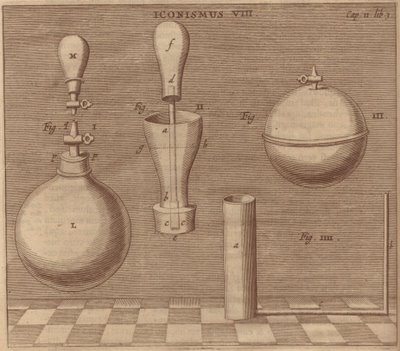
'Experimentum quo nubes ac ventus
iridisque colores in vitris excitari possunt'
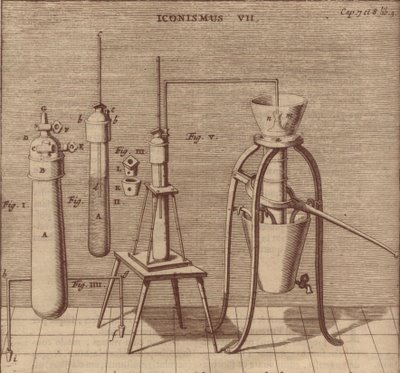
'De modo vacuo exhibendi'
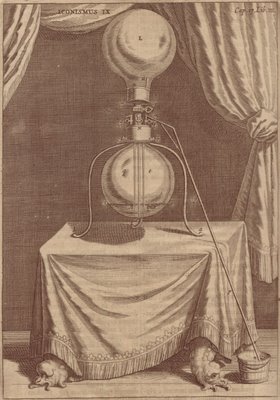
'De machinae alicujus hydraulico-pneumauticae constructione'
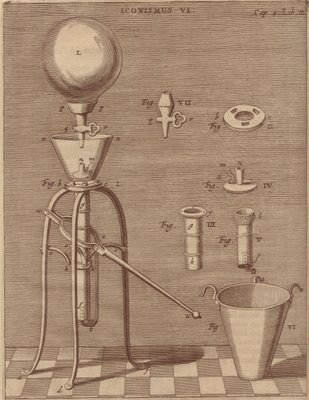
'De constructione singularis alicujus machinae, pro efficiendo vacuo'
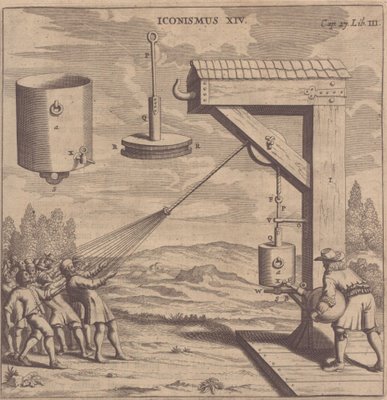
'De vase vitreo plures quam viginti vel 50 et
plures homines robustos attrahere valente'
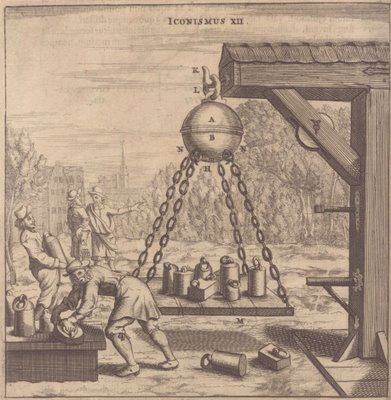
'Aliud experimentum quo ostenditur lances
seu phialae praedictas pondere divell'
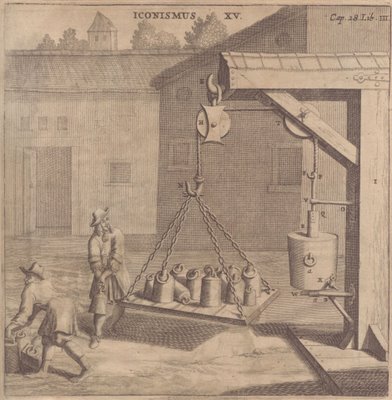
'Experimentum ingens pondus elevandi'
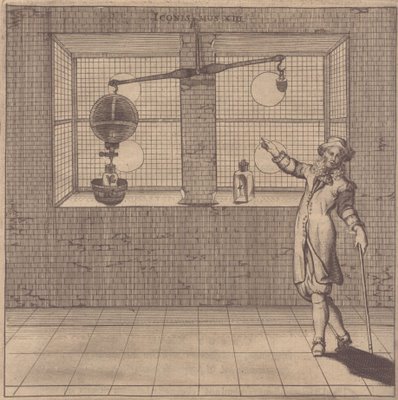
'Aliud experimentum quid nimirum aeris gravitas operari
possit comprimendo scilicet frangendo omnia vasa'
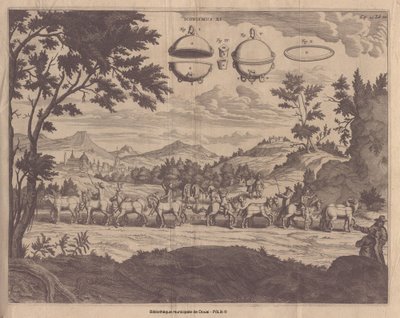
'Experimentum quo ostenditur quod propter aeris gravitatem
duae phialae ita conjugi ut a 16 equis non distrahi possunt'
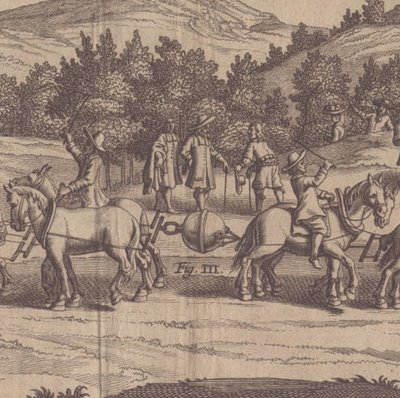
[detail from above]
"The Magdeburg Hemispheres
With a modified stirrup pump he pumped the air out of two metal hemispheres which had been fitted together with nothing more than grease. He hitched a team of eight horses to each hemisphere, but they were not strong enough to separate them. The weight of the air acting on the hemispheres — atmospheric pressure — exerted a greater force."
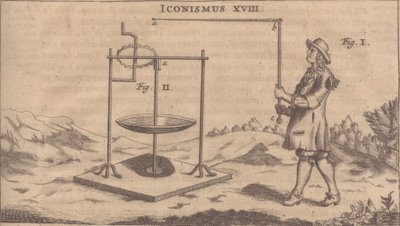
'Experimentum a tam rectaquam cirular'
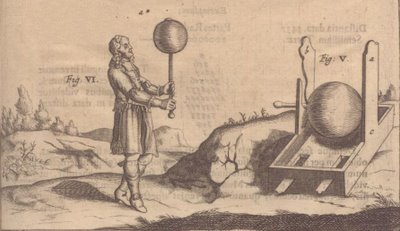 'Experimentum a tam vortice ipso quam circulatione'
'Experimentum a tam vortice ipso quam circulatione'[The above 2 images are details from the same page]
With an aristocratic heritage and an education in law, mathematics and fortress building, Prussian Otto von Guericke
(1602-1686) first distinguished himself by providing engineering assistance during the reconstruction of the town of Madgeburg after it was destroyed in a war in 1631. He would go on to serve as Mayor and Magistrate of the town until he was in his mid-70s.
Guericke studied astronomy and was keenly supportive of the Copernican view as to the arrangement of the universe. He was fascinated by the movement and forces acting on bodies in empty space and when he saw a comet through a telescope he rightly opined that these phenomena return into view regularly. Hence, the book under present consideration included an early section (see
Part I) outlining Guericke's astronomical calculations.
He read the works of Torricelli, Pascal and Galileo and repeated experiments relating to measuring atmospheric pressure, from which he made weather predictions. He "proposed a network of stations to make systematic reports of the barometer and weather. He made a special barometer in which the column of mercury moved the arm of a man, which thus pointed out rising and falling pressure."
Many of the above engravings depict pumps made by Guericke in his quest to disprove Aristotle's notion of 'horror vacui' - an hypothesis that stated that a vacuum cannot exist: 'nature abhors a vacuum'. Moving on from a suction pump to an air pump, Guericke conducted numerous experiments on vacuums, demonstrating that the air pressure can perform useful work, that fire requires air to burn and that grapes can last 6 months inside a vacuum. These experiments reached a spectacular climax when in 1657, the above Madgeburg Hemisphere's experiment with horses was performed before Emperor Ferdinand III (the image is very famous in physics circles). These vacuum pump experiments were first
reported by Gaspar Schott in his 1657 book
'Mechanica Hydraulico-Pneumatica'.
The final image above shows what some regard as the first electrical machine (generator). Guericke constructed a sulphur sphere which could be rotated by a crank and which produced sparks (static electricity -- he didn't know this at the time). Once friction had set up a charge in the sphere, it could be removed from its housing for experiments - Guericke was the first to witness electroluminescence and he determined that like charges repel each other. He also did further experimental work in relation to magnets.
The fact that he did all this - demonstrated vacuums for the first time, performed foundation experiments for the science of meteorology, constructed a static electricity machine (to name just 3) - while working as Magistrate, Mayor and Diplomat is just extraordinary. I confess to never having heard of him previously but now, after having read around, I'm seriously impressed. Polymath, first class.
Otto von Guericke's book was published in 1672 and is called:
'Experimenta nova (ut vocantur) magdeburgica de vacuo spatio primùm à r. p. Gaspare Schotto ... nunc verò ab ipso auctore perfectiùs edita, variisque aliis exmerimentis aucta. Quibus accesserunt simul certa quaedam de aëris pondere circa terram; de virtutibus mundanis, & systemate mundi planetario; sicut & de stellis fixis, ac spatio illo immenso, quod tàm intra quam extra eas funditur'The images here and in the
previous post from '
Experimenta Nova'
(I think I've posted all but 1 or 2 illustrations) come from
Bibliothèque Patrimoniale Virtuelle - Pôle Universitaire Européen Lille-Nord-Pas-de-Calais [click: 'Double écran' then 'Index iconographique']
Unusually, I think I was lucky finding this book at
this particular library. After jagging and uploading all the images I discovered that there are a few other versions online:
** In my humble opinion moves by institutions to imprint over illustrations ought to be protested and resitsted wherever possible, with respect to 'out of copyright' material. Either the institution shouldn't post the work online, or high resolution images should be preserved beneath zoom architecture if, for whatever reason, they wish to restrict access to downloadable large image files.
The point here is that the illustration was not made with an H*A*B watermark in the middle of the page and it is, in essence, a disfigurement of public art. Obviously I/we have a vested interest in practices such as these being discouraged, but it seems to me that the institution's ownership of the digitized version can be made plain with either or both copyright notices or a watermark in an inobtrusive location on the page.
I'm moved to comment because H.A.B. is one of the finest online digital repositories and it bodes uneasily for the future of digitized public domain works if such an excellent institution is resorting to these controlling measures. (nb. I haven't checked this out more thoroughly - I just loaded one of their page images from the above link - whether it's just newly uploaded science books or whether they are going back through their catalogue I don't know, so there is a possibility that I'm mischaracterizing the circumstances. I'll return there sometime soon no doubt.)
